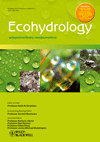Effects of typhoon Morakot on a large shallow lake ecosystem, Lake Taihu, China
ABSTRACT
A case study of typhoon-induced sediment resuspension and its effects on some indicators of water quality (dissolved oxygen, pH and turbidity) and nutrient release in the large shallow eutrophic Lake Taihu, the third largest freshwater lake in China, was documented, and its effect on the algal biomass was investigated. Typhoon Morakot that swept from the west of Lake Taihu in August 2009 led to a number of changes in the lake ecosystem: (1) intensive winds produced large seiches, strong waves and large wave-induced shear stress; (2) typhoon Morakot led to increased suspended solids and nutrients in the water column. Post-typhoon concentrations of suspended solid, total phosphorus, total nitrogen, soluble reactive phosphorus (SRP). NO3-N and NH4-N were 4, 2, 1·5, 2·5, 3·5 and 1·5 times those observed in the pre-typhoon water column, respectively; and (3) during typhoon Morakot, there was no obvious stratification between the surface and bottom of the water column in chlorophyll a (Chl a), the post-typhoon Chl a concentration throughout the water column increased with a maximum daily mean of 87·8 µg l−1, and the algal bloom recurred. Typhoon-induced sediment resuspension could lead to both nutrient and light limitations for algal growth, whereas after the typhoon had passed, water column conditions (water temperature, solar radiation, light penetration and nutrient availability) favoured the growth and production of algae. Copyright © 2011 John Wiley & Sons, Ltd.
INTRODUCTION
Shallow lakes are characterized by the episodic resuspension of sediments. Several hydrodynamic processes can induce sediment resuspension, although wind-induced waves are usually the main driving force in shallow lakes (Hakanson, 2005). Frequent resuspension induced by wind events generally occurs over temporal scales from minutes to hours (Villard et al., 1999; Liu and Huang, 2009), which may affect the function of lake ecosystems. Sediment resuspension can increase total nitrogen (TN) and total phosphorus (TP) in the water column (Sondergaard et al., 1992; Hamilton and Mitchell, 1997; Laurion et al., 1997; Villard et al., 1999), which indirectly influences algae through supplying nutrients (Schallenberg and Burns, 2004; Dzialowski et al., 2008) and increasing turbidity in water column reducing the penetration of light, which thereby decreases planktonic primary production (Laurion et al., 1997; Tarras-Wahlberg et al., 2002).
Extreme natural events, such as typhoons, can amplify the effect of intense hydrodynamics on the lake ecosystem. Short-term studies have found that a typhoon could create a pulse of nutrient phosphorus into the water column changing the phosphorus limitation stage (Robarts and Waiser, 1998) and could also resuspend organic matter for phytoplankton consumption (Paerl et al., 2001; Tsai et al., 2008). Long-term ecosystem observations showed that an extreme typhoon not only uprooted large quantities of aquatic plants (James et al., 2008) but also switched the primary producer community of lake ecosystem from macrophyte dominance to phytoplankton dominance (Bachmann et al., 2000).
In 2009, Lake Taihu was influenced by two typhoons (Linfa in June, Morakot in April). Typhoon Linfa only affected the south edge of Lake Taihu. Typhoon Morakot was generated in the north-western Pacific on 4 August and made landfall on Taiwan on 7 August causing the most severe natural disaster in southern Taiwan in 50 years and leading to record-breaking rainfall in southern Taiwan. The eye of typhoon Morakot arrived at the south of Lake Taihu at 02:00 h on 11 August with its centre wind of grade 8 and the maximum wind speed of 20 m s−1. The typhoon departed from Lake Taihu at 20:00 h on 11 August with its centre wind of grade 7 and the maximum wind speed of 16 m s−1.
Lake Taihu is the third largest freshwater lake in China (area 2338 km2) and is also very shallow (mean depth 1·9 m). It is situated in the Yangtze delta, one of the most industrialized and urbanized regions of China (Qin et al., 2007). Water quality of Lake Taihu has been deteriorating since the 1980s because of the drastic effects of anthropogenic activities (Qin et al., 2007). Lake Taihu belongs to the subtropical monsoon climate and is swept by typhoons several times each year during July–September (Qin, 2008). So far, there have been few studies on the effects of typhoons on the lake environment and ecosystem. Most documented studies concerning hydrodynamic effects on the lake environment and water quality have been limited to laboratory flume experiments of sediment resuspension on overlying water quality (Sun et al., 2006) or development of numerical models to reproduce the water currents and waves and their effect on sediment resuspension and water quality (Hu et al., 2006b). Some observations on wind-induced sediment resuspension have only focused on water quality (Fan et al., 2003; Sun et al., 2006; You et al., 2007; Zhu et al., 2007; Wu et al., 2009), with less attention given to the lake ecosystem. This limitation is partly because it is difficult to collect long-term, high-frequency data for hydrodynamics, especially in extreme typhoon events.
Despite the ecological importance of strong wind events, very little monitoring and research have been conducted in the shallow Lake Taihu. The objective of this paper is to provide information about effects of extreme weather events on eutrophic shallow lakes. We documented the effect of typhoon-related changes to hydrodynamics, water quality and the plankton in Lake Taihu and attempted to reveal the effects of hydrodynamics on algal bloom production.
DATA AND METHODS
Site description
Typhoon process observation was conducted in the Taihu Laboratory for Lake Ecosystem Research (TLLER) that is located at the southern side of Meiliang Bay, Lake Taihu (Figure 1). Meiliang Bay is situated north of Lake Taihu with an area of 130 km2; 50% of the bottom is covered by silt and overlain with mean sediment depth of 1·5 m (Fan et al., 2000). The nutrient status of Meiliang Bay changed from an oligomesotrophic state with low algal biomass before 1981 to a eutrophic state with Microcystis blooms during 1988–1995 and then to hypereutrophic conditions with the dominance of Planctonema and TP of up to 200 mg m−3 during 1996–1997 (Chen et al., 2003). At present, the dominant phytoplankton species are Microcystis, Anabaena, Melosira, Cyclotella and Cryptomonas. Microcystis spp. account for 85% of algae biomass and form an algal bloom every summer (Chen et al., 2003; Qin et al., 2007).

The observation site is at the end of a 100-m long pier in TLLER where the bottom soft sediment thickness is about 0·2 m. Near the observation site, there are two regular water quality observation sites of TLLER, which have been monitored every month since 1991. The prevailing wind of Lake Taihu was from south-southwest in May and east-southeast in June, July and August, whereas at the observation site, winds from west, west-southwest, south-west, south-southwest and south with long wind fetch length always produce intensive waves.
Measurements
Wind direction and speed, precipitation, air temperature, and solar radiation were continuously recorded by Lake Taihu automatic meteorological stations located at the observation site, collecting a set of data every 10 min. A buoy was deployed in October 2007 in TLLER to record a set of parameters including dissolved oxygen (DO), chlorophyll a (Chl a), turbidity and pH of surface (0·2 m under water) and bottom (0·5 m above sediment) every 10 min. All sondes were clean and calibrated biweekly. In addition, water temperature was measured every 10 min with thermistor chains at several depths to plot the temperature profile. A SonTek/YSI Argonaut fixed on the platform was deployed under water to collect the data set of current and waves with a 15-min sampling interval.
Before typhoon Morakot arrived at Lake Taihu (on 8–10 August), water samples were collected once a day. On 11 August, with wind speed increasing, the sampling frequency was increased, and four samplings were undertaken. Triplicate samples were taken from four water depths (0·15, 0·5, 1 and 2 m above sediment). Pumping into isolated pipes at each water depth eliminated interference and provided samples that were characteristic of that particular water depth.
Analytical methods
Water samples were divided into two subsamples, with one set of subsamples immediately filtered (GF/C, Whatman) for Chl a analysis and the other filtered for suspended solid (SS). To determine the SS, the remaining particulate matter on the filters after 100–250 ml sampling water was dried at 105 °C for 4 h until its weight decreased to a constant. Loss on ignition (LOI) was measured by a 4-h ignition of the dried particulate matter on the membrane at 550 °C. Chl a was obtained through filtering GF/C filters, extracted with ethanol (90%) at 80 °C and analysed spectrophotometrically at 750 and 665 nm, with correction for phaeopigments (Chen and Gao, 2000). TN, TP, total dissolved nitrogen (TDN), and total dissolved phosphorus (TDP) concentrations were determined after thawing with the use of a combined persulfate digestion (Ebina et al., 1983) followed by spectrophotometric analysis as for soluble reactive phosphorus and nitrate (Qian and Fu, 1987). Correlation and regression analyses were carried out with spss 16 software.
Calculation of shear stress
 ) on SWI. Wave movement formed benthic wave shear stress (
) on SWI. Wave movement formed benthic wave shear stress ( ) on SWI. When shear stress produced by water movement exceeded the critical shear stress, the sediment would start to suspend. According to the hydraulic judging criteria, the critical stress for sediment resuspension means that the surface sediment particles began to gradually float upward. Previous research has shown that the critical shear stress for initializing the sediment resuspension approximately ranges from 0·01 to 0·1 N m−2, and the average critical shear stress (
) on SWI. When shear stress produced by water movement exceeded the critical shear stress, the sediment would start to suspend. According to the hydraulic judging criteria, the critical stress for sediment resuspension means that the surface sediment particles began to gradually float upward. Previous research has shown that the critical shear stress for initializing the sediment resuspension approximately ranges from 0·01 to 0·1 N m−2, and the average critical shear stress ( ) of Lake Taihu is 0·037 N m−2 (Luo and Qin, 2003; Qin et al., 2000). Wave shear stress is obtained using the following equation (Sheng and Lick, 1979):
) of Lake Taihu is 0·037 N m−2 (Luo and Qin, 2003; Qin et al., 2000). Wave shear stress is obtained using the following equation (Sheng and Lick, 1979):
 (1)
(1) (2)
(2) (3)
(3) (4)
(4) , k0 is the Karman constant (0·4), uz is the current velocity at z (in metre) above the lake bottom and Z0 is the bottom roughness set at 0·2 mm (Hawley, 2000; Nielsen et al., 2001; Luo and Qin, 2003).
, k0 is the Karman constant (0·4), uz is the current velocity at z (in metre) above the lake bottom and Z0 is the bottom roughness set at 0·2 mm (Hawley, 2000; Nielsen et al., 2001; Luo and Qin, 2003).RESULTS
Wind and hydrodynamics
The winds during the typhoon Morakot observation are presented in Figure 2. During the pre-typhoon stage (8–10 August), the dominant wind direction was north-east (Figure 2a), and the peak wind speed reached 11·8 m s−1 (Figure 2b). North-easterly, wind had a very short fetch; therefore, wind-induced seiches were not large enough to produce large wave heights and current velocities. The mean significant wave height (Hs) was less than 0·04 m (Figure 3a), and the mean current velocity was 0·028 m s−1 with the maximum current velocity 0·135 m s−1, which lasted very shortly (Figure 3a). During the pre-typhoon period, both wave and current shear stress were significantly less than the critical shear stress of Lake Taihu (Figure 3b). On 11 August, the typhoon eye arrived at Lake Taihu and swept from south to west over the lake with the wind direction gradually turning west and the wind fetch length becoming increasingly large. During this typhoon period (11–12 August), the wind peak speed reached 12 m s−1 and blew predominantly from west with long wind fetch; so large seiches were produced with the maximum Hs of 0·27 m and  of 0·183 N m−2 (Figure 3), which was significantly larger than the critical shear stress. However, the benthic current velocity did not increase with wind speed. In the afternoon on 12 August, typhoon Morakot was slowly leaving Lake Taihu, and the energy of the wind gradually decreased with mean wind speed of 4 m s−1 (Figure 2b). So the wave and current in post-typhoon period gradually decreased to pre-typhoon level.
of 0·183 N m−2 (Figure 3), which was significantly larger than the critical shear stress. However, the benthic current velocity did not increase with wind speed. In the afternoon on 12 August, typhoon Morakot was slowly leaving Lake Taihu, and the energy of the wind gradually decreased with mean wind speed of 4 m s−1 (Figure 2b). So the wave and current in post-typhoon period gradually decreased to pre-typhoon level.

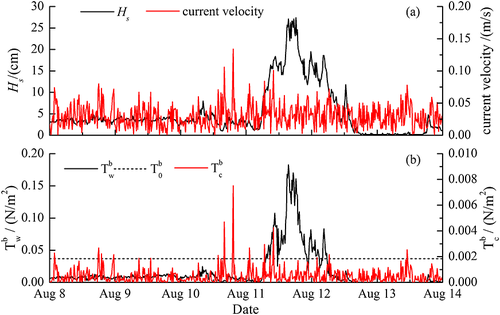
Nutrients, DO and pH
On 8 August, the SS concentration was 121 g m−2 (Figure 4a). With wave shear stress increasing, SS in water column gradually increased and reached 498 g m−2 on 11 August (Figure 4a). After typhoon Morakot had passed, the SS concentration was 131 g m−2, which was the same as the pre-typhoon level on 8 August. Assuming that SS concentration in water column on 8 August was indicative of a background value without resuspension, SS concentration at the peak of the typhoon on 11 August was four times of background value. In the pre-typhoon period, LOI accounted for 19% of SS on 8 August (Figure 4a). In 11 August, very strong wave action resulted in significant resuspension of both sediment and organic matter. However, LOI in SS reduced to 9%, which indicated that resuspended matter was dominated by inorganic particles. LOI rates in the post-typhoon period reduced back to 16% with SSs settling into the lake sediment.
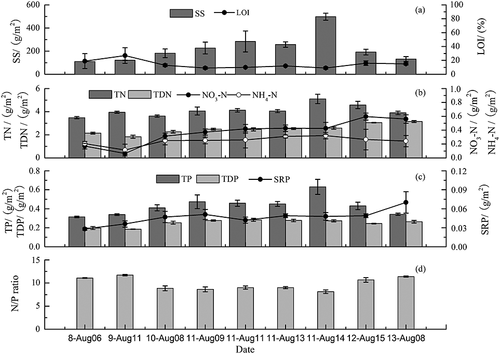
In addition to SS concentration increasing during typhoon Morakot (Figure 4a), TN concentration in the water column also increased substantially (Figure 4b). NO3-N and NH4-N (Figure 4b) were the two main forms of dissolved nitrogen in the water column, and both had similar variations with TN during the pre-typhoon and typhoon periods. During the post-typhoon period (12–14 August), NO3-N gradually increased and was 3·5 times larger than the pre-typhoon period, whereas NH4-N gradually decreased compared with the pre-typhoon period. Correlation analysis showed that the correlation coefficients of significant wave heights with TN, TDN, NO3-N and NH4-N were 0·487, −0·135, 0·119 and 0·597, respectively (Table 1). There was no significant relationship between nitrogen concentration and Hs, suggesting that the concentration in the water column of the various forms of nitrogen released from sediment may not be simply determined by hydrodynamic processes but may be moderated by biochemical processes such as nitrification and denitrification that take effect during sediment resuspension.
| Hs | SS | TN | TP | TDN | TDP | NO3-N | NH4-N | SRP | |
|---|---|---|---|---|---|---|---|---|---|
| Hs | 1 | — | — | — | — | — | — | — | — |
| SS | 0·787* | 1 | — | — | — | — | — | — | — |
| TN | 0·487 | 0·837** | 1 | — | — | — | — | — | — |
| TP | 0·790* | 0·963** | 0·836** | 1 | — | — | — | — | — |
| TDN | −0·135 | 0·137 | −0·035 | 0·069 | 1 | — | — | — | — |
| TDP | 0·744* | 0·629 | 0·201 | 0·669* | 0·340 | 1 | — | — | — |
| NO3-N | 0·119 | 0·310 | 0·087 | 0·252 | 0·949** | 0·545 | 1 | — | — |
| NH4-N | 0·597 | 0·712* | 0·347 | 0·704* | 0·530 | 0·820** | 0·649 | 1 | — |
| SRP | −0·046 | 0·093 | −0·086 | 0·090 | 0·693* | 0·462 | 0·661 | 0·311 | 1 |
- SS, suspended solid; TN, total nitrogen; TP, total phosphorus; TDN, total dissolved nitrogen; TDP, total dissolved phosphorus; SRP, soluble reactive phosphorus.
- * Correlation is significant at the 0·05 level (two-tailed).
- ** Correlation is significant at the 0·01 level (two-tailed).
Typhoon Morakot also led to substantial increases of TP and TDP concentrations in the water column (Figure 4c). Correlation coefficients of Hs with TP and TDP were 0·790 and 0·744 (Table 1). TP, TDP and SRP concentrations in the water column during typhoon Morakot were 1·8 times greater than those in the pre-typhoon water column (Figure 4c). When the hydrodynamic forces in the lake become weak on 13 August, post-typhoon SRP concentrations in the water column were 2·5 times greater than pre-typhoon concentrations (Figure 4c). Table 1 also shows that SRP had no significant relation with wave significant heights. Sediment resuspension also affected the TN : TP ratio in the water column. During pre-typhoon and post-typhoon periods, the mean TN : TP ratio in the water column was 11·2, and the mean TN : TP ratio was 8·7 during the typhoon period (Figure 4d).
During the observation period, DO, saturation percent of dissolved oxygen (SDO) and pH were also recorded and presented in Figure 5. DO and SDO fluctuated from 5·92 to 8·23 mg l−1 and from 73·8% to 106%, respectively (Figure 5a). Both DO and SDO showed similar trends, with the values in typhoon periods slightly lower than those in the calm condition. pH in the water column ranged from 6·9 to 9·1, with a high frequency of oscillation during the typhoon period especially from 08:00 h on 11 August to 24:00 h on 12 August (Figure 5b).
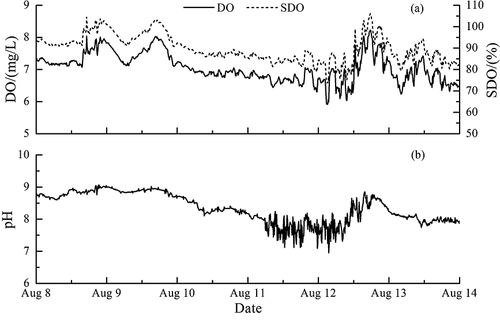
Turbidity
The temporal series of turbidity indicated that sediment resuspension events clearly occurred during typhoon Morakot. The background turbidity values for pre-typhoon and post-typhoon ranged from 18 to 25 nephelometric turbidity units (NTU) (Figure 6). Turbidity peaked at more than 150 NTU during the typhoon when wind speed increased to 12 m s−1. Turbidity peak values were generally short-lived and closely related to windy conditions. As typhoon Morakot moved away from Lake Taihu, the turbidity in the water column returned to background levels. However, turbidity events lasted up to 34 h during typhoon Morakot, which may have significant impact on primary production of phytoplankton in the lake ecosystem.

Algae biomass
Chlorophyll a was continuously recorded by sonde (Figure 7) at the surface (Chlasrf) and bottom (Chladp) of the water column. Chlasrf and Chladp ranged from 6·6 to 16·2 µg l−1 and from 4·2 to 16·4 µg l−1, respectively. Both exhibited similar trends, with Chl a concentrations during typhoon Morakot were slightly lower than pre-typhoon and post-typhoon. By establishing the relationship (p < 0·01) between Chl a concentration obtained by filtering on GF/C and extracting by spectrophotometry with Chl a concentration recorded by the sonde (Figure 8), the continuous adjusted sonde that recorded Chl a concentrations from 1 to 20 August were obtained (Figure 9). During 1–7 August, Chlasrf was slightly larger than Chladp, with the maximum concentration of <20 µg l−1 (Figure 9). From 8 to 11 August, Chlasrf was equal to Chladp for water column mixing, with maximum concentration of <18 µg l−1 (Figure 9). From 12 August, Chl a concentration in the water column gradually increased, and the concentration difference between Chlasrf and Chladp increased to form an obvious stratification in the water column. On 18 August, Chlasrf concentration increased to 87·8 µg l−1.
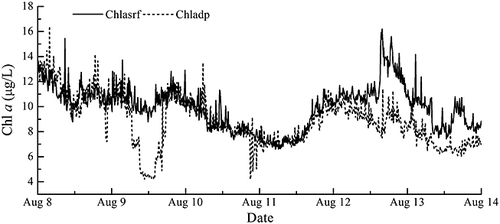

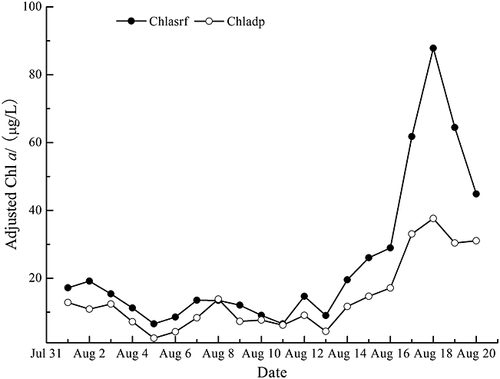
DISCUSSION
Hydrodynamic and sediment resuspension
Lake Taihu is swept by typhoons every year (Qin, 2008), although the intensities of individual typhoons are variable. Typhoon Morakot was not the strongest storm to move over the lake in recent years, but it exposed the lake ecosystem to high winds for several days. In previous research in Lake Taihu, significant sediment suspension begins when the wind speed exceeds 6·5 m s−1 with long wind fetch length (Qin and Hu, 2000; Qin and Zhu, 2006). Under these conditions, shear stress induced by wind exceeds the critical shear stress. Comparing current shear stress with wave shear stress during typhoon Morakot showed that  was ten times larger than
was ten times larger than  under weak hydrodynamic processes, whereas
under weak hydrodynamic processes, whereas  was three orders of magnitude larger than
was three orders of magnitude larger than  under strong wind conditions. The bottom shear stresses associated with currents were too small to influence the SS concentration (Leuttich et al., 1990; Douglas and Rippey, 2000; Luo and Qin, 2003). Importantly,
under strong wind conditions. The bottom shear stresses associated with currents were too small to influence the SS concentration (Leuttich et al., 1990; Douglas and Rippey, 2000; Luo and Qin, 2003). Importantly,  was much higher than the critical shear stress (Figure 3b). The maximum wave shear stress was 0·183 N m−2 because of the maximum wind speed of 12 m s−1 with long wind fetch length, and this induced an SS concentration increase in the water column to 498 g m−2. Previous research in Lake Taihu has found that the top 0·05–0·10 m of sediment is an active layer in physical and chemical features interacting with overlaying water (Qin and Luo, 2004), which was in line with other lakes (Viner, 1975). However, strong wind generally results in forced entrainment of the upper few millimetres of the lake bed into water column (Hu et al., 2006a). Strong wind events could also change the sediment environment, such as increasing the upper sediment column water content (James et al., 2008); so the critical shear stress of the upper sediment could weaken, leading to an increase of sediment resuspension ratios (Trolle et al., 2009).
was much higher than the critical shear stress (Figure 3b). The maximum wave shear stress was 0·183 N m−2 because of the maximum wind speed of 12 m s−1 with long wind fetch length, and this induced an SS concentration increase in the water column to 498 g m−2. Previous research in Lake Taihu has found that the top 0·05–0·10 m of sediment is an active layer in physical and chemical features interacting with overlaying water (Qin and Luo, 2004), which was in line with other lakes (Viner, 1975). However, strong wind generally results in forced entrainment of the upper few millimetres of the lake bed into water column (Hu et al., 2006a). Strong wind events could also change the sediment environment, such as increasing the upper sediment column water content (James et al., 2008); so the critical shear stress of the upper sediment could weaken, leading to an increase of sediment resuspension ratios (Trolle et al., 2009).
Nutrients
Pathways for nutrients fluxing into the upper mixed water column include riverine inflows, atmospheric wet deposition and sediment resuspension (Xu and Qin, 2005; Luo et al., 2007a; Luo et al., 2007b; Shields et al., 2009). Riverine inputs of nutrients were not fully monitored during typhoon Morakot, but the total typhoon event rainfall of 41·2 mm produced only a small increase in riverine inflow. Table 2 shows that the nutrient concentration of atmospheric wet deposition was much less than the water column. Therefore, we disregarded direct riverine inflows and atmospheric wet deposition as major sources of nutrients during this event. The resulting correlation analysis showed that SS, TP and TN are significantly related to significant wave heights (Table 1), indicating that nutrients released by sediment resuspension was a major source of nutrients in the water column during typhoon Morakot. Typhoon Morakot induced sediment resuspension, creating a pulse of nutrients trapped in the surface layer of the bottom sediments fluxing into the water column. The increases of TN and TP in the water column immediately following typhoon Morakot were expected on the basis of the results from previous research in Lake Taihu (Fan et al., 2004; Zhu et al., 2005; Luo et al., 2006; Zhu et al., 2007). Although most of the nutrients are in particulate form, as an important phosphorus source, about 58% of TP would be hydrolyzed as inorganic phosphate to compensate for phosphorus deficiency of algal growth (Gao et al., 2006). Internal loading during the storms contributed to a 1·5-fold to twofold increase in water column TN and TP concentrations, compared with pre-typhoon (Figures 4b and 4c). Unlike TP, the change of soluble reactive phosphorus in the water column during resuspension is apparently complex and variable in Lake Taihu, as it has been shown to be in other lakes (Sondergaard et al., 1992; Robarts and Waiser, 1998; Nausch et al., 2004). SRP in water column decreased during the typhoon and rapidly increased shortly after the typhoon event ended (Figures 4b and 4c). Sondergaard et al. (Sondergaard et al., 1992) show that SRP was independent on both the amount of sediment resuspension and the duration of wind events. SRP concentration in the water column during sediment resuspension is influenced by a number of factors, including the equilibrium of nutrients between the water and sediment, pH, adsorption–desorption, the Fe : P ratio and redox condition of sediment (Sondergaard et al., 1992). Research in Lake Taihu has shown that the Fe : P ratio in sediment ranged from 20 to 40 (Qin et al., 2006); this is much greater than 15 and means the suspended particles had a strong ability to adsorb phosphorus. After the typhoon, particles slowly settled out of the water column (Figure 4a), and the increase pH could be expected to induce phosphorus partitioning from particulate phases to dissolved phases (Sondergaard et al., 1992).
| TN | TDN | NH4-N | NO3-N | TP | TDP | SRP | |
|---|---|---|---|---|---|---|---|
| Mean(mg l−1) | 1·267 | 1·100 | 0·627 | 0·218 | 0·026 | 0·093 | 0·003 |
| Standard deviation | 0·035 | 0·062 | 0·035 | 0·042 | 0·008 | 0·098 | 0·002 |
- TN, total nitrogen; TP, total phosphorus.
Unlike P, N in the water column can be removed by N fixation and denitrification (McCarthy et al., 2007). Both of these processes are significant in Lake Taihu. Sediment resuspension induced by typhoon Morakot increased NO3-N and NH4-N concentrations; however, in the post-typhoon period, NO3-N still increased but NH4-N gradually decreased. Because of the different responses of N and P to sediment resuspension, typhoon Morakot decreased TN : TP ratios, which in turn affect the nutrient limits for phytoplankton (Robarts and Waiser, 1998; Xu et al., 2010) and increase the cyanobacteria proportion in the phytoplankton community (McCarthy et al., 2007; James et al., 2009).
Turbidity
Light penetration is a key factor limiting photosynthesis in the water column and can be assessed by Secchi transparency (Zhang et al., 2007). Turbidity recorded by sonde showed that turbidity was related to wave significant heights (Figure 10a), and correlation analysis showed turbidity caused by wind-induced sediment resuspension was positively correlated to wave significant height (r = 0·76, Figure 10a) rather than wind speed. Turbidity, with SS and Chl a, was analysed by stepwise regression analysis, and the optimization model eliminated Chl a. Then, a significant linear relationship between SS and turbidity was found for data recorded during the observation period (r = 0·64, Figure 10b), indicating that sediment resuspension was the main factor responsible for increasing turbidity in water column. During typhoon Morakot, SS increased the turbidity of the water column and decreased the light transmission into the water column. The reduction of light transmission in a lake can directly decrease the primary productivity of phytoplankton in water column (Schallenberg and Burns, 2004). For shallow and well-mixed lakes, sediment resuspension inhibits photosynthesis below 0·5–1 m water depth (Dickman et al., 1998). In summer, Secchi transparency was approximately 0·5 m and the photosynthetically active radiation (PAR) euphotic depth has been reported as 1·34 m (±0·18) in Meiliang Bay (Zhang et al., 2006). Given mean lake depth of 1·9 m, it is clear that sediment resuspension will reduce the PAR depth and inhibit algae growth.
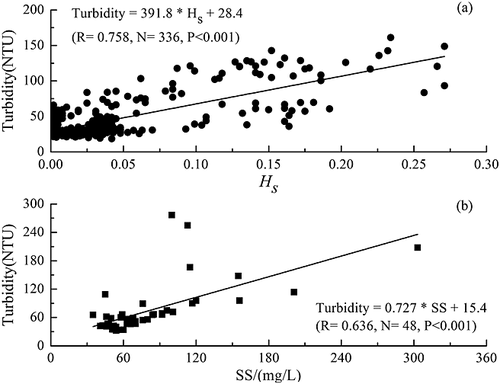
Algal blooms
In some eutrophic shallow lakes, the increases of algal biomass as estimated by Chl a are closely correlated with wind-induced resuspension events (Schelske et al., 1995; Hamilton and Mitchell, 1997). Sediment resuspension may lead to increased algal biomass through a combination of two mechanisms. Large concentrations of nitrogen and phosphorus during the typhoon Morakot could be cycled back into the water column during typhoon resuspension events (Figure 4). Previous research suggests that Lake Taihu is often nutrient-limited. Bioassay experiments with nutrient additions in Meiliang Bay showed that algal growth could be limited by P alone in spring and colimited by P and N during summer and autumn (Xu et al., 2010), which implicated that the algal bloom formation requires nutrient supply. Sediment resuspension could increase water column nutrients following wind events, thereby, releasing algae from nutrient limitations. In addition to indirectly influencing algae through nutrient additions, sediment resuspension could also transport meroplankton into the water column (Carrick et al., 1993, Schelske et al., 1995) and meroplankton from the sediment has been reported to increase in the water column following resuspension events (Carrick et al., 1993; Dzialowski et al., 2008).
Figure 9 shows the change of Chl a concentration during 1–20 August. Before the onset of the typhoon (1–7 August), algae biomass ranged from 2·32 µg l−1 to 19·14 µg l−1, and during the typhoon (8–13 August), sediment resuspension did not rapidly increase algae biomass. However, the algae biomass increased rapidly after the typhoon had ended. This suggests that prior to the typhoon, algae growth may be limited by nutrients during 1–7 August. When the typhoon swept the lake ecosystem, low solar radiation, low temperature (Figure 11) and high turbidity (Figure 6) inhibited algae growth on 10–11 August, and phytoplankton production was light-limited. After the typhoon (after 12 August), solar radiation, temperature and turbidity returned to the normal level but dissolved nutrients, especially biological available nutrients in water column, stayed at a high level (Figure 4c). The light-limitation and nutrient-limitation status of phytoplankton were gradually relieved, leading to good conditions for the growth and production of algae.
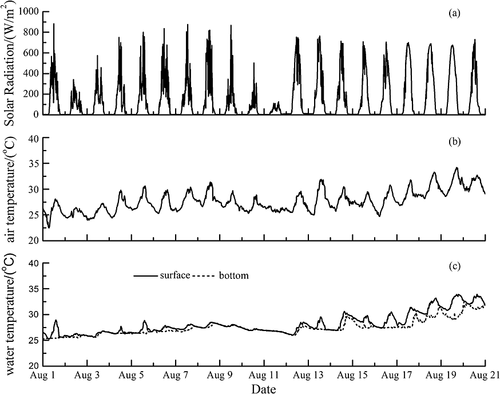
ACKNOWLEDGEMENTS
We thank editor Keith Smettem for the language editing and anonymous reviewers for the constructive comments on the manuscript. We also thank Dr Guang Gao for providing the data about the water quality of rainfall during typhoon Morakot. This research was supported by the National Natural Science Foundation of China (40825004, 40730529, 40801200, 41101458) and the Knowledge Innovation Project of Chinese Academy of Sciences (KZCX1-YW-14,KZCX2-YW-419).



